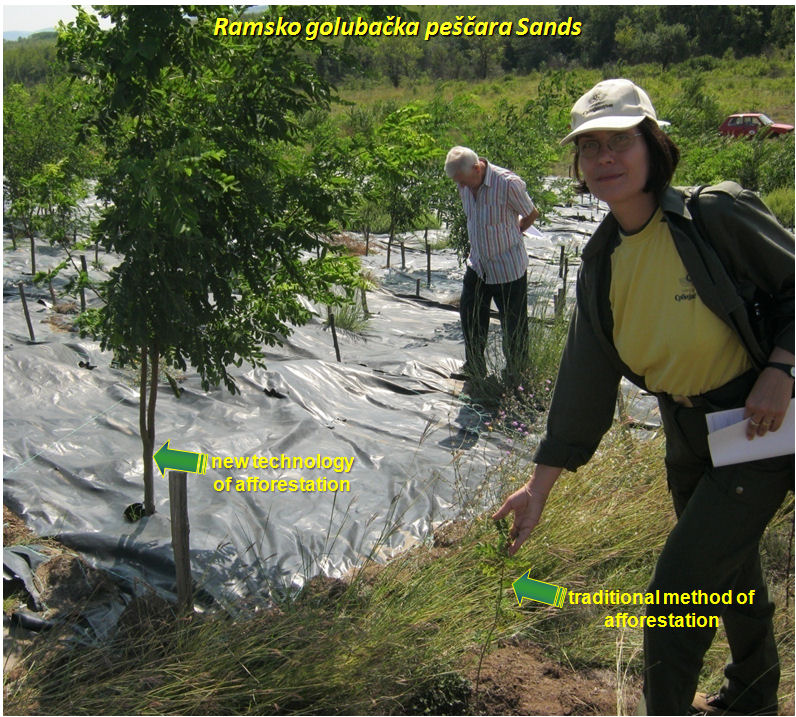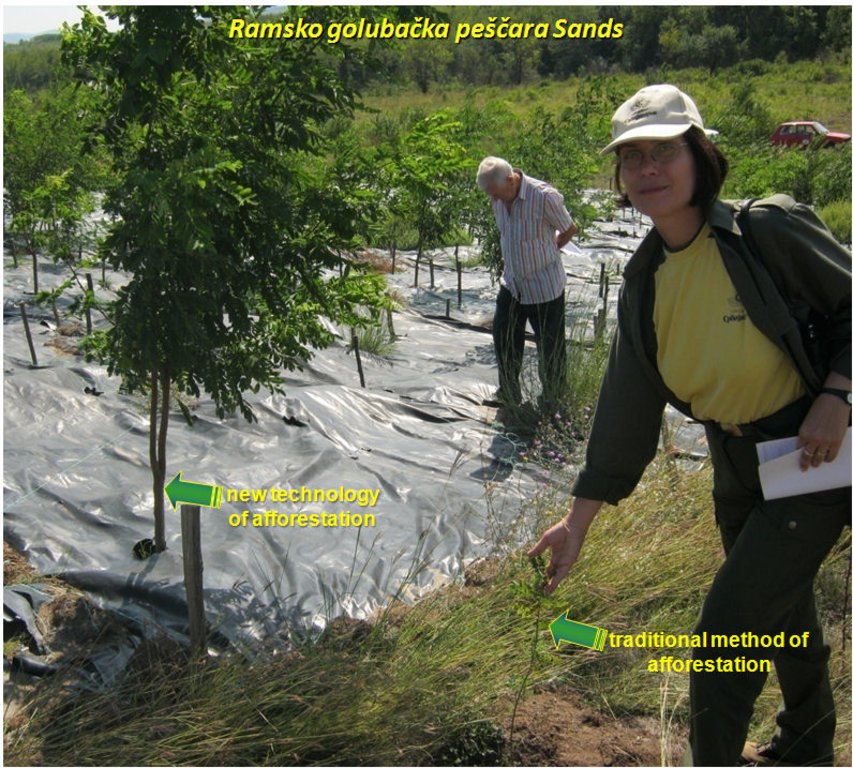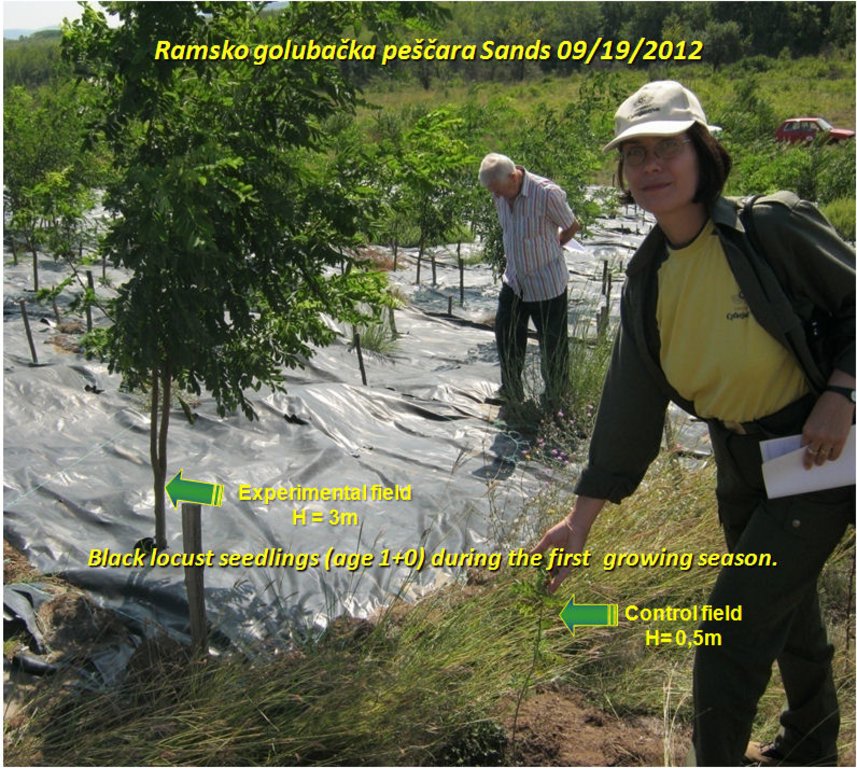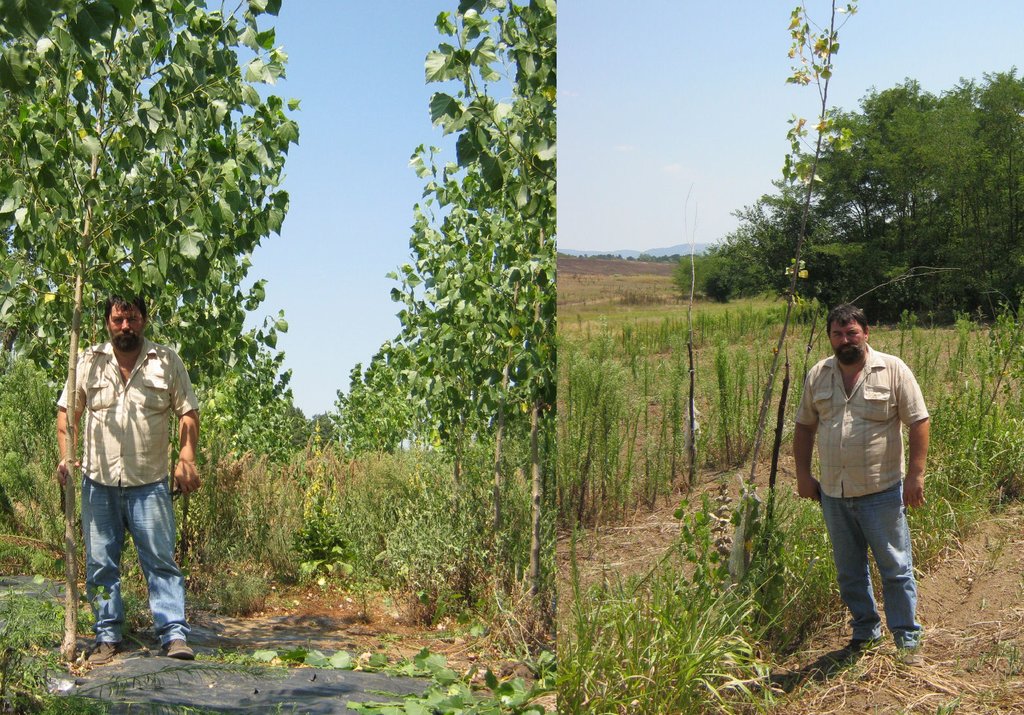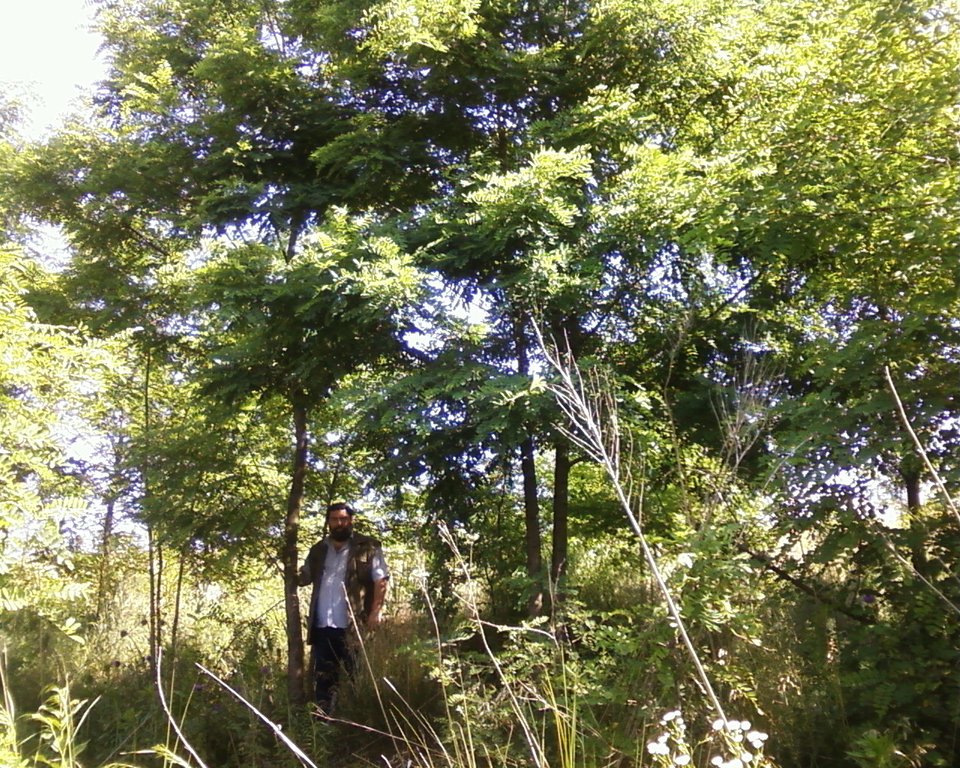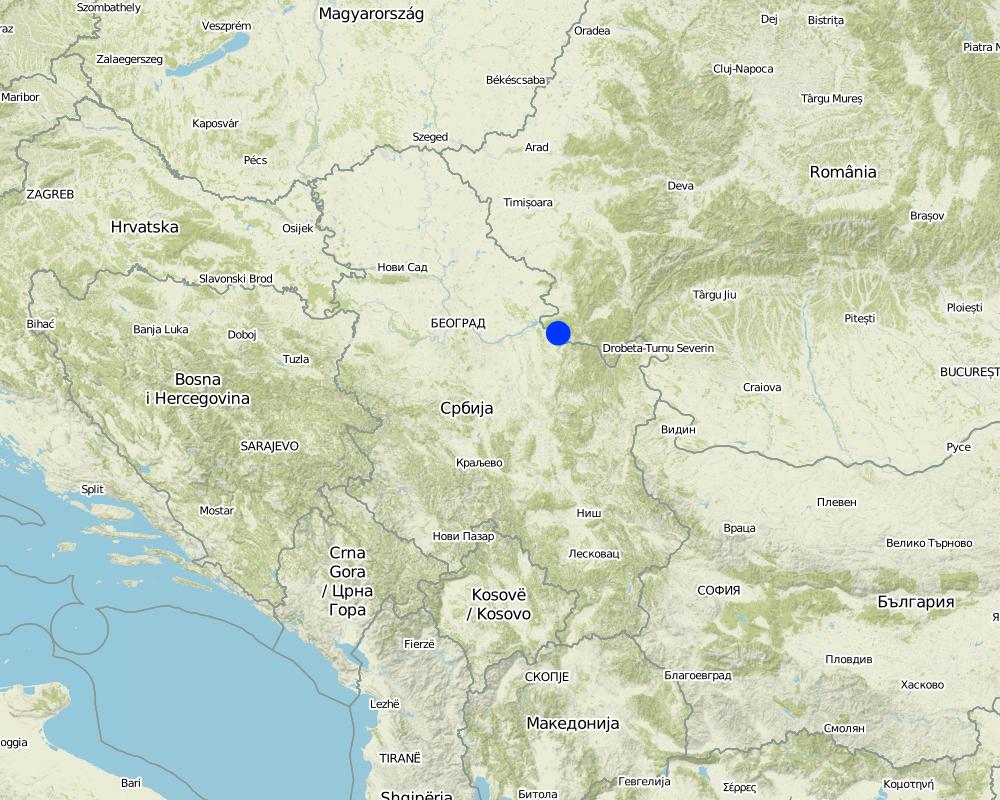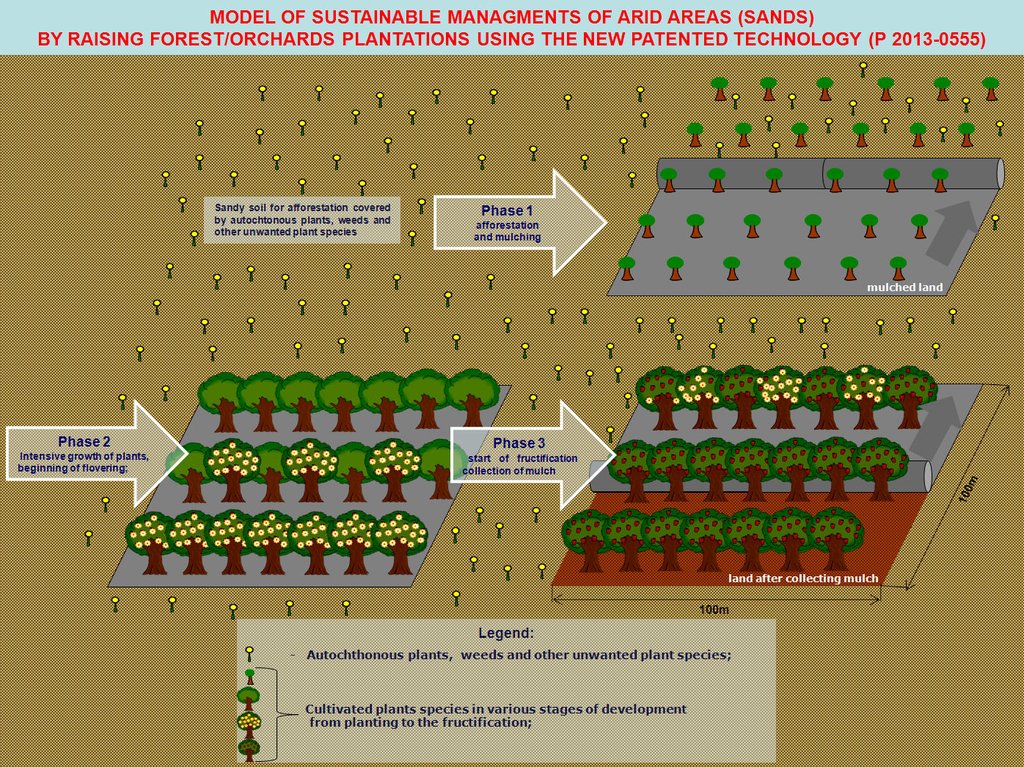New patented technology of raising forest and orchards in the extremely unfavorable environmental conditions [Serbia]
- Creation:
- Update:
- Compiler: Blagoje Pejić
- Editor: –
- Reviewer: Alexandra Gavilano
The Procedure Complete Mulching of Land In Order to Raise Young Plantations of Woody Plants Under Unfavorable Climate Conditions P 2013 - 0555
technologies_500 - Serbia
View sections
Expand all Collapse all1. General information
1.2 Contact details of resource persons and institutions involved in the assessment and documentation of the Technology
1.3 Conditions regarding the use of data documented through WOCAT
The compiler and key resource person(s) accept the conditions regarding the use of data documented through WOCAT:
Yes
1.4 Declaration on sustainability of the described Technology
Is the Technology described here problematic with regard to land degradation, so that it cannot be declared a sustainable land management technology?
No
Comments:
This technology does not pollute the environment and completely excludes the use of chemical agents in the control of undesirable plant species.
2. Description of the SLM Technology
2.1 Short description of the Technology
Definition of the Technology:
The technological process of complete mulching with specific materials (P 2013 – 0555) has a positive impact on the development, e.g. the growth intensity and the growth time of the cultivated plant species. This technology allows to grow plants without additional irrigation in rather poor habitat conditions (high temperature, insolation, etc.).
2.2 Detailed description of the Technology
Description:
1. This technology has been applied in arid conditions Ramsko golubačka peščara Sands (East Serbia). This semi deserts is one of three located in Serbia. As is known, all the ecosystems (agro, forest and water ecosystems) in the surrounding of sands and deserts are highly endangered by wind erosion, which causes movement and transport of the sand and damage to people, agronomy and biodiversity. This is poor area, inhabited by the Roma population - highly affected by the consequences of moving sands;
2. This process of complete mulching of land with specific polyethylene foil enables use of poor habitat conditions (high temperature, insolation and etc) tor a positive impact on the development of plants. This innovative technology provides fully use of the reserves of moisture and mineral matters in the soil, as well as intensification of the process of photosynthesis of cultivated plants, which are the main reasons for the rapid growth and exceptionally good overall condition of young plantations
3 The purpose of this technology is to increase success of the procedure and ensure the achievement of the targeted functionality of woody plants (binding and greening sands, ensuring of food and wind shelter for humans and wild animals, increasing biodiversity) in a much shorter period of time than traditional methods afforestation.
4. In relation to the works that follow the classical techniques to raise woody plants, for this patented technology is necessary to additionally provide a trained workforce for the setting up of mulch, specific material for mulching and license to use the patent. To establish this technology trained workforces are required to set up the specific materials for mulching, taking care of the plants, as well a license to use the patented technology must be acquired
5. Based on the principle “make it and leave it” this technological process enables the following conditions: no need for additional irrigation; no need for mechanical soil cultivation before afforestation; no need for additional manpower and works that are required in maintaining young forest plantations raised by classical methods of afforestation (hoeing, inter-row processing, harrowing, weeds and stump sprout removing...); in the next 3-5 years completely prevented the appearance of unwanted species of plants (weeds) without the use of chemicals; no environmental pollution; no soil erosion as well as rinsing and removal of humus on slopes; fructification of fruit tree species starting earlier, shelterbelts and snow protective belts are usable for far less time, the sands bind is faster, afforestation of degraded land and the process of rehabilitation and recultivation is shortened, production cycle of energy crops takes less time and give faster return on investment, binding of sands and stop wind erosion has a positive impact on the microclimate of whole sandy area and helps to increase the biodiversity as well as increase of yields of agricultural crop.
6. Although the cumulative amount of costs of implementing the patented technology is much lower compared to the works following the classic techniques to raise woody plants, an aggravating circumstance for the use of this technology may be the obligation to hold a license to use the patent and greater capital investment in the first year of plantation. Users especially likes fact that young plantations reaches the targeted purposes for drastically shorter time, without additional irrigation.
2.3 Photos of the Technology
General remarks regarding photos:
The pictures show the difference between the results of the use of traditional technology of afforestation and the use of new patented technologies of afforestation
2.5 Country/ region/ locations where the Technology has been applied and which are covered by this assessment
Country:
Serbia
Region/ State/ Province:
Veliko Gradište
Further specification of location:
Ramsko golubačka peščara Sands
Specify the spread of the Technology:
- evenly spread over an area
Map
×2.6 Date of implementation
If precise year is not known, indicate approximate date:
- less than 10 years ago (recently)
2.7 Introduction of the Technology
Specify how the Technology was introduced:
- during experiments/ research
3. Classification of the SLM Technology
3.1 Main purpose(s) of the Technology
- improve production
- reduce, prevent, restore land degradation
- conserve ecosystem
- protect a watershed/ downstream areas – in combination with other Technologies
- preserve/ improve biodiversity
- reduce risk of disasters
- adapt to climate change/ extremes and its impacts
- mitigate climate change and its impacts
- create beneficial economic impact
- create beneficial social impact
3.2 Current land use type(s) where the Technology is applied

Forest/ woodlands
- Tree plantation, afforestation
- Forest fruits plantations
Tree plantation, afforestation: Specify origin and composition of species:
- Monoculture local variety
- Mixed varieties
Products and services:
- Fuelwood
- Fruits and nuts
- Other forest products
- Nature conservation/ protection
Comments:
Number of growing seasons per year: 1
3.4 Water supply
Water supply for the land on which the Technology is applied:
- rainfed
Comments:
This technological process exclude additional irrigation and provide enough moisture for the life of cultivated plant species without the need for irrigation young plants, relying only on the water from atmospheric precipitates.
3.5 SLM group to which the Technology belongs
- forest plantation management
- windbreak/ shelterbelt
- improved ground/ vegetation cover
3.6 SLM measures comprising the Technology

structural measures
- S6: Walls, barriers, palisades, fences
- S11: Others
3.7 Main types of land degradation addressed by the Technology

soil erosion by water
- Wt: loss of topsoil/ surface erosion

soil erosion by wind
- Et: loss of topsoil
- Ed: deflation and deposition
3.8 Prevention, reduction, or restoration of land degradation
Specify the goal of the Technology with regard to land degradation:
- prevent land degradation
- restore/ rehabilitate severely degraded land
Comments:
This is applicable model to combat desertification and sustainable management of Sands, using by the new technology of raising forest (and orchards) in arid areas, which ensure the achievement of the targeted functionality of woody plantations in a much shorter period of time than traditional methods afforestation, without additional irrigation, just relying on the existing atmospheric sediment
4. Technical specifications, implementation activities, inputs, and costs
4.1 Technical drawing of the Technology
Technical specifications (related to technical drawing):
This patented technological process of complete mulching of land enables use of poor habitat conditions (high temperature, insolation and etc.) for a positive impact on the intense growth and development of cultivated species of plants and provides, even in harsh environmental conditions, successful establishment of forest and orchards plantations, planting of new forests in areas where in the past did not exist and the conversion of stands of lower quality in higher silvicultural form, all without additional irrigation.
The news is a specific and layered process laying mulch and full coverage of land with specific, impermeable to water and light, synthetic materials over large areas. In this way, planted trees provides full access to the existing reserves of moisture and nutrients in the soil and suppress weeds, without the use of herbicides and pesticides and without the need for irrigation young plants, relying only on the water from atmospheric precipitates.
After completion of the production cycles, all the material used for mulching will be collected and recycled, which confirms that new technology has a zero degree of environmental pollution.
Author:
Dr. Blagoje Pejić
Date:
19/09/2012
4.2 General information regarding the calculation of inputs and costs
Specify how costs and inputs were calculated:
- per Technology area
Indicate size and area unit:
1ha
other/ national currency (specify):
€ (Euro)
Indicate average wage cost of hired labour per day:
35€ (gross amount)
4.3 Establishment activities
| Activity | Timing (season) | |
|---|---|---|
| 1. | Marking and measuring of places for planting | 2 workers (8hours) |
| 2. | Digging a hole for planting (40cm x 40 cm) | 11 workers (8hours) |
| 3. | Delivery seedlings | 4 workers (8hours) |
| 4. | Planting seedlings | 8 workers (8hours) |
| 5. | Placing (stacking) of mulch | 12 workers (8hours) |
4.4 Costs and inputs needed for establishment
| Specify input | Unit | Quantity | Costs per Unit | Total costs per input | % of costs borne by land users | |
|---|---|---|---|---|---|---|
| Labour | workers | person - days | 37.0 | 35.0 | 1295.0 | |
| Labour | skilled labor force | person - days | 3.0 | 100.0 | 300.0 | |
| Equipment | Machine hours | working hours | 10.0 | 15.0 | 150.0 | |
| Equipment | Tools | kom | 10.0 | 10.0 | 100.0 | |
| Plant material | Seedlings | kom | 1300.0 | 1.0 | 1300.0 | |
| Fertilizers and biocides | Zeolite | kg | 910.0 | 0.32 | 291.2 | |
| Construction material | Material for mulching | square meter | 10000.0 | 0.22 | 2200.0 | |
| Other | Licence | ha | 1.0 | 500.0 | 500.0 | |
| Other | Transport of seedlings | Euro | 1300.0 | 0.01 | 13.0 | |
| Other | Transport of workers | Euro | 37.0 | 0.7 | 25.9 | |
| Total costs for establishment of the Technology | 6175.1 | |||||
| Total costs for establishment of the Technology in USD | 6175.1 | |||||
Comments:
The amount of the costs of raising young plantations (forest and orchard) refers to a period of 5 years, as planned duration of mulch. Based on the principle “make it and leave it”, during the period of duration of mulch, this technological process enables the following conditions: NO NEED for additional irrigation - provide enough moisture for the life of cultivated plant species without the need for irrigation young plants, relying only on the water from atmospheric precipitates; NO NEED for mechanical soil cultivation before afforestation; NO NEED for additional manpower and works that are required in maintaining young forest plantations raised by classical methods of afforestation (hoeing, inter-row processing, harrowing, weeds and stump sprout removing...). In the next 5 years completely prevented the appearance of unwanted species of plants (weeds) without the use of chemicals; NO environmental pollution; NO soil erosion as well as rinsing and removal of humus on slopes.
4.5 Maintenance/ recurrent activities
| Activity | Timing/ frequency | |
|---|---|---|
| 1. | Maintenance of mulch | 3 workers (8hours) |
4.6 Costs and inputs needed for maintenance/ recurrent activities (per year)
| Specify input | Unit | Quantity | Costs per Unit | Total costs per input | % of costs borne by land users | |
|---|---|---|---|---|---|---|
| Labour | workers | person - days | 3.0 | 35.0 | 105.0 | |
| Total costs for maintenance of the Technology | 105.0 | |||||
| Total costs for maintenance of the Technology in USD | 105.0 | |||||
5. Natural and human environment
5.1 Climate
Annual rainfall
- < 250 mm
- 251-500 mm
- 501-750 mm
- 751-1,000 mm
- 1,001-1,500 mm
- 1,501-2,000 mm
- 2,001-3,000 mm
- 3,001-4,000 mm
- > 4,000 mm
Specify average annual rainfall (if known), in mm:
420.00
Specifications/ comments on rainfall:
Precipitation are distributed unfavorably for the planted seedlings, given that the largest deficit was recorded in the middle of the growing season.
The sum of annual insolation (average for the period 1981-2010) = 2073.8h;
Average temperature (average for the period 1981-2010) = 11.3ºC
Indicate the name of the reference meteorological station considered:
Meteorological station Veliko Gradište
Agro-climatic zone
- semi-arid
According to Lang's classification, the researched area of Ramsko golubačka peščara Sands belongs into the category of semi arid climate areas (55.5)
5.2 Topography
Slopes on average:
- flat (0-2%)
- gentle (3-5%)
- moderate (6-10%)
- rolling (11-15%)
- hilly (16-30%)
- steep (31-60%)
- very steep (>60%)
Landforms:
- plateau/plains
- ridges
- mountain slopes
- hill slopes
- footslopes
- valley floors
Altitudinal zone:
- 0-100 m a.s.l.
- 101-500 m a.s.l.
- 501-1,000 m a.s.l.
- 1,001-1,500 m a.s.l.
- 1,501-2,000 m a.s.l.
- 2,001-2,500 m a.s.l.
- 2,501-3,000 m a.s.l.
- 3,001-4,000 m a.s.l.
- > 4,000 m a.s.l.
Indicate if the Technology is specifically applied in:
- not relevant
5.3 Soils
Soil depth on average:
- very shallow (0-20 cm)
- shallow (21-50 cm)
- moderately deep (51-80 cm)
- deep (81-120 cm)
- very deep (> 120 cm)
Soil texture (topsoil):
- coarse/ light (sandy)
Soil texture (> 20 cm below surface):
- coarse/ light (sandy)
Topsoil organic matter:
- medium (1-3%)
If available, attach full soil description or specify the available information, e.g. soil type, soil PH/ acidity, Cation Exchange Capacity, nitrogen, salinity etc.
pH in KCL Depth 0-30cm = 5.98 (slightly acidic), Depth 30-60cm = 6.63 (neutrally);
CaCo3 (%) Depth 0-30cm = 0.00 (no carbonate), Depth 30-60cm = 0.00 (no carbonate);
Humus (%) Depth 0-30cm = 2.96 (low humus), Depth 30-60cm = 2.34 (low humus);
Nitrogen Depth 0-30cm = 0.148 (well supplied), Depth 30-60cm = 0.117 (well supplied);
P2O5 (mg/100gr) Depth 0-30cm = 5.99 (poor), Depth 30-60cm = 6.04 (poor);
K2O (mg/100gr) Depth 0-30cm = 7.50 (poor), Depth 30-60cm = 4.00 (poor);
5.4 Water availability and quality
Ground water table:
5-50 m
Availability of surface water:
medium
Water quality (untreated):
for agricultural use only (irrigation)
Is water salinity a problem?
No
Is flooding of the area occurring?
No
5.5 Biodiversity
Species diversity:
- low
Habitat diversity:
- low
5.6 Characteristics of land users applying the Technology
Sedentary or nomadic:
- Sedentary
Market orientation of production system:
- subsistence (self-supply)
Off-farm income:
- less than 10% of all income
Relative level of wealth:
- very poor
Individuals or groups:
- individual/ household
Level of mechanization:
- manual work
Gender:
- men
Age of land users:
- middle-aged
5.7 Average area of land used by land users applying the Technology
- < 0.5 ha
- 0.5-1 ha
- 1-2 ha
- 2-5 ha
- 5-15 ha
- 15-50 ha
- 50-100 ha
- 100-500 ha
- 500-1,000 ha
- 1,000-10,000 ha
- > 10,000 ha
Is this considered small-, medium- or large-scale (referring to local context)?
- medium-scale
5.8 Land ownership, land use rights, and water use rights
Land ownership:
- state
- company
Land use rights:
- communal (organized)
- individual
Water use rights:
- open access (unorganized)
- individual
5.9 Access to services and infrastructure
health:
- poor
- moderate
- good
education:
- poor
- moderate
- good
technical assistance:
- poor
- moderate
- good
employment (e.g. off-farm):
- poor
- moderate
- good
markets:
- poor
- moderate
- good
energy:
- poor
- moderate
- good
roads and transport:
- poor
- moderate
- good
drinking water and sanitation:
- poor
- moderate
- good
financial services:
- poor
- moderate
- good
6. Impacts and concluding statements
6.1 On-site impacts the Technology has shown
Socio-economic impacts
Production
crop production
Quantity before SLM:
-3
Quantity after SLM:
3
Comments/ specify:
During studied period in the “Ramsko-Golubačka peščara” Sands, recorded seedling survival rate:
on the experimental area 80-100%;
on the control area 0-7%.
crop quality
Quantity before SLM:
-2
Quantity after SLM:
3
Comments/ specify:
During studied period in the “Ramsko-Golubačka peščara” Sands, seedlings showed vigorous growth, a large amount of leaf mass, and excellent overall vitality of the plants, which the results are unusual even for a very good habitat!
on the experimental area H = 3m;
on the control area H = 0.5m
wood production
Quantity before SLM:
-2
Quantity after SLM:
3
Comments/ specify:
In accordance with ecology cultivated species of trees - this technology, even in unfavorable habitats, enables faster growth of cultivated plant species, thus shortening the transition from plantations in the forest, and to achieve specific purposes, which indicates that the used method has success, even in harsh climates sands and deserts, where classical methods of afforestation does not give the desired results.
forest/ woodland quality
Quantity before SLM:
-3
Quantity after SLM:
3
Comments/ specify:
This new patented technology (P 2013-055) provides, even in the extremely harsh environmental conditions, better water and air regime of soil, which improves overall quality of the land and drastically increases the chances for success of the afforestation
production area
Quantity before SLM:
0
Quantity after SLM:
3
Comments/ specify:
This technology improves overall quality of the land
land management
Quantity before SLM:
-2
Quantity after SLM:
2
Comments/ specify:
The new technology of raising forest provides sustainable use of soils of lower quality (sands).
Income and costs
economic disparities
Quantity before SLM:
-1
Quantity after SLM:
2
Comments/ specify:
The cost of applying these technological methods of raising young seedlings were higher in the first year of life, but the cumulative costs, over a five-year maintenance period plantation tree species, is much lower than in traditional afforestation methods.
Other socio-economic impacts
Stop desertification
Quantity before SLM:
-3
Quantity after SLM:
3
Comments/ specify:
All the ecosystems (agro, forest and water ecosystems) near the deserts are highly endangered by different destructive processes, primarily by wind erosion. Wind erosion is a very destructive factor, causes movement and transport of the sand and consequential damages to people, agricultural crops and entire biodiversity. This is why the community in the Veliko Gradište (Eastern Serbia), especially people who are living on the periphery of the Ramsko golubačka peščara Sands - where themselves provide food (fruits of the forest) and job (forestry and agriculture), is highly affected by the consequences of moving sands.
This technology have a special significance for the wider community because it provides a successful model for stopping desertification and conservation/enhancement of biodiversity and protect settlements and agricultural crops from the negative effects of moving sands.
Socio-cultural impacts
food security/ self-sufficiency
Quantity before SLM:
-1
Quantity after SLM:
2
Comments/ specify:
The new technology provides sustainable use of soils of lower quality (sands) by raising forest/orchards plantations and, in same time, provides food and wind shelter for humans and wild animals on the long-term period.
Ecological impacts
Water cycle/ runoff
evaporation
Quantity before SLM:
-3
Quantity after SLM:
3
Comments/ specify:
Reduces the cost of water provide enough moisture for the life of cultivated plant species, without the need for irrigation young plants
Soil
soil moisture
Quantity before SLM:
0
Quantity after SLM:
3
Comments/ specify:
This patented technology provides improvement of the water-air properties, Also, water retention of precipitation in the root zone of cultivated species is provided on the way that moisture is accessible only to the cultivated plants.
soil cover
Quantity before SLM:
-1
Quantity after SLM:
3
Comments/ specify:
This innovative technology provides a wider choice of high quality tree species for afforestation and creates conditions for sustainable use of sands.
soil loss
Quantity before SLM:
0
Quantity after SLM:
3
Comments/ specify:
The forest plantations, as natural windshield, have a main role in stopping the moving sands and soil loss.
soil accumulation
Quantity before SLM:
-1
Quantity after SLM:
3
Comments/ specify:
This patented technology increase reserves of moisture and nutrients in the soil in a way that reserves of moisture and nutrients in the soil is accessible only cultivated plants
Biodiversity: vegetation, animals
Vegetation cover
Quantity before SLM:
-2
Quantity after SLM:
2
invasive alien species
Quantity before SLM:
-1
Quantity after SLM:
2
Comments/ specify:
The occurrence of unwanted (invasive alien) species of plants is completely prevented , without the use of chemicals;
animal diversity
Quantity before SLM:
-1
Quantity after SLM:
2
Comments/ specify:
Increasing forest area and providing food and shelter for wildlife has a positive impact on increasing biodiversity
6.2 Off-site impacts the Technology has shown
water availability
Quantity before SLM:
-3
Quantity after SLM:
2
Comments/ specify:
This technology provide enough moisture for the life of cultivated plant species without the need for irrigation young plants, improves soil moisture regime reducing the cost of water, without the negative trends in terms of the presence of nutrients and without additional irrigation - relying only on the water from atmospheric precipitates;
6.3 Exposure and sensitivity of the Technology to gradual climate change and climate-related extremes/ disasters (as perceived by land users)
Gradual climate change
Gradual climate change
| Season | increase or decrease | How does the Technology cope with it? | |
|---|---|---|---|
| seasonal temperature | summer | increase | very well |
| seasonal rainfall | summer | decrease | very well |
Climate-related extremes (disasters)
Hydrological disasters
| How does the Technology cope with it? | |
|---|---|
| general (river) flood | not well |
6.4 Cost-benefit analysis
How do the benefits compare with the establishment costs (from land users’ perspective)?
Short-term returns:
slightly positive
Long-term returns:
slightly positive
How do the benefits compare with the maintenance/ recurrent costs (from land users' perspective)?
Short-term returns:
positive
Long-term returns:
very positive
6.5 Adoption of the Technology
- single cases/ experimental
Of all those who have adopted the Technology, how many did so spontaneously, i.e. without receiving any material incentives/ payments?
- 0-10%
Comments:
The patented technology provides the ability to use a wider choice of tree species for successful afforestation in arid conditions, so now it is possible to use and plant species that are less tolerant to drought conditions. These plant species cannot be successfully used in dry areas in the case of classical technologies of afforestation.
6.6 Adaptation
Has the Technology been modified recently to adapt to changing conditions?
Yes
If yes, indicate to which changing conditions it was adapted:
- climatic change/ extremes
Specify adaptation of the Technology (design, material/ species, etc.):
The presented technology provides the possibility of using a wider choice of tree species for successful afforestation in harsh environmental conditions.
6.7 Strengths/ advantages/ opportunities of the Technology
| Strengths/ advantages/ opportunities in the land user’s view |
|---|
|
This technology provides enough moisture for the life of cultivated plant species without the need for irrigation young plants, improves soil moisture regime reducing the cost of water, without the negative trends in terms of the presence of nutrients and without additional irrigation - relying only on the water from atmospheric precipitates. This technology does not pollute the environment because it completely excludes the use of chemical agents in the control of undesirable plant species, which is vital for the quality of soil and groundwater, as well as for existing populations of wild animals. After completion of the production cycles, all the material used for mulching will be collected and recycled, which confirms that new technology has a zero degree of environmental pollution. |
7. References and links
7.1 Methods/ sources of information
7.2 References to available publications
Title, author, year, ISBN:
"Afforestation of semideserts, sands, and areas exposed to intense insolation using the new technologies of raising forest plantations"; Pejić, B., Lavadinović, V., Dražić, N., Jestretijević, N., ; 2014
Available from where? Costs?
International Conference “Enhancing Biodiversity in Mediterranean Ecosystems from Theory to Practice” 18-20 June, Thessaloniki, Greece
Title, author, year, ISBN:
"Application of New Technologies in Raising of Woody Plantations (P 2013-0555) For Sustainable Management of Land With Poorer Quality On the Example of Ramsko golubačka peščara Sands; 2015, Pejić, B., Petrović, A., Bajić, J., Dražić, N., Jestretijević, N.,; 2015
Available from where? Costs?
VII International Conference „COAL 2015“, Zlatibor, 14-17.October, Zlatibor, Serbia.
Title, author, year, ISBN:
"Land Conservation and Sustainable Use of Sands Using the New Patented Technology of Raising Woody Plantations P 2013-0555" ; Pejić, B., Zlatić, M., ; 2016
Available from where? Costs?
“The Third World Conference of World Association of Soil and Water Conservation, Belgrade
7.3 Links to relevant online information
Title/ description:
web site: www.sumailov.rs
URL:
http://www.sumailov.rs/index%20English.html
Links and modules
Expand all Collapse allLinks
No links
Modules
No modules


